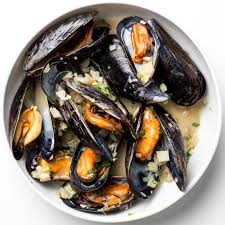Mussels, those small, bivalve mollusks with their distinctive fan-shaped shells, have been a staple in human diets for millennia. They are found in coastal waters around the world, attaching themselves to rocks, piers, and other hard surfaces. Mussels are not only delicious but also play important roles in marine ecosystems.
Mussel Anatomy and Biology
Mussels have a simple body plan, consisting of a mantle, gills, and a muscular foot. The mantle is a fleshy tissue that secretes the shell, which is composed of calcium carbonate. The gills are used for respiration and filtering food particles from the water. The muscular foot is used for attachment and movement.
Mussels are filter feeders, extracting nutrients from the water column. They play a vital role in water purification by removing pollutants and excess nutrients. Mussels are also a food source for a variety of marine animals, including fish, crabs, and birds.
Mussel Diversity
Mussels come in a wide variety of shapes, sizes, and colors. Some of the most common mussel species include:
- Blue mussel: This species is found in coastal waters of the Northern Hemisphere and is the most commercially important mussel.
- Green mussel: This species is found in coastal waters of the Southern Hemisphere and is similar in appearance to the blue mussel.
- Mediterranean mussel: This species is found in the Mediterranean Sea and is characterized by its elongated shell.
- Periwinkle mussel: Periwinkle mussels are smaller than other mussels and have a more rounded shell.
Mussels in Human Culture
Mussels have been consumed by humans for thousands of years. They are a popular seafood dish in many parts of the world, enjoyed in various cuisines. Mussels can be steamed, baked, fried, or grilled. They are often served with garlic butter, white wine, or herbs.
In addition to their culinary importance, mussels have cultural significance in some regions. They are often associated with coastal living and maritime traditions.
Mussel Farming and Sustainability
Mussel farming, also known as mytiliculture, is a sustainable form of aquaculture. Mussels are grown in controlled environments, often suspended from ropes or rafts. This method of farming has several advantages, including low environmental impact and high yields.
However, mussel farming can also have negative consequences. Overfishing of wild mussel populations and pollution can threaten the sustainability of mussel stocks. Sustainable farming practices and responsible management are essential to ensure the long-term viability of mussel populations.
Mussels are fascinating creatures that offer both culinary delights and ecological benefits. By understanding their biology, ecology, and the challenges they face, we can appreciate their importance and support sustainable practices to protect these valuable marine resources.
